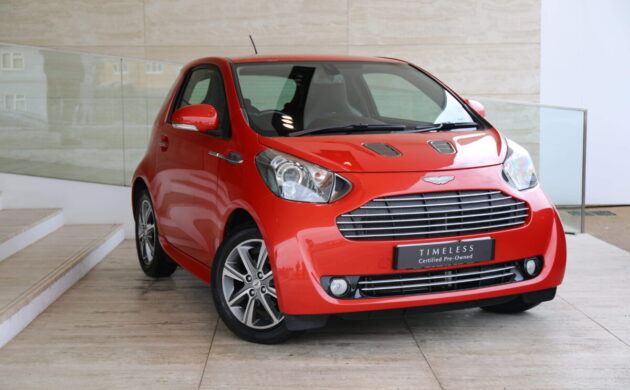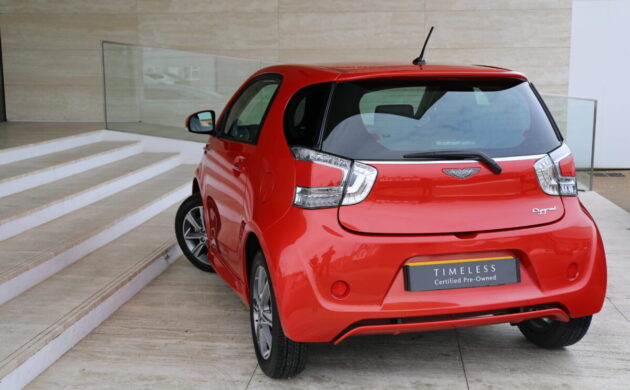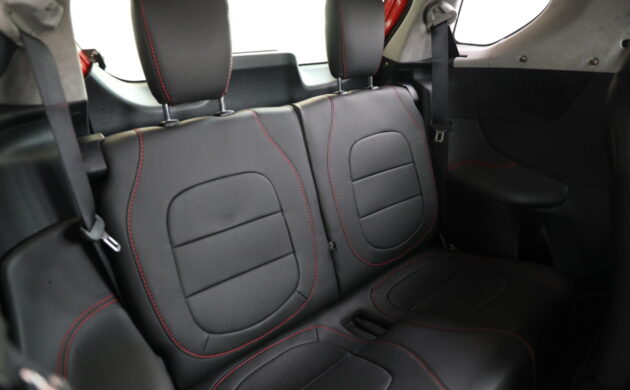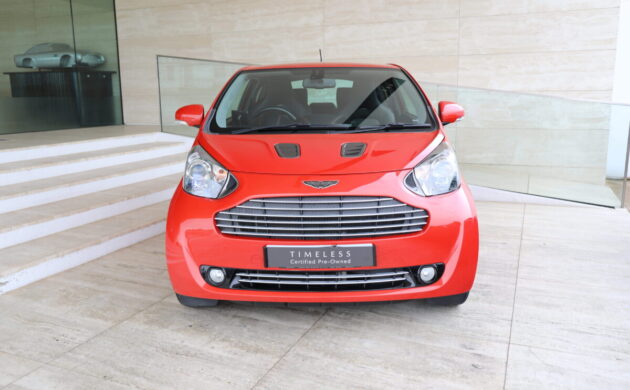Have you ever done something that seemed like a good idea at the time, but hindsight demonstrated it was a massive error of judgment? Yeah, me too! Automotive manufacturers are not immune from the occasional disaster, with the history books brimming with cars their creators would rather forget. That could well be the story behind the 2011 Aston Martin Cygnet. Introduced to comply with upcoming European Union fleet-average emission regulations, it failed to sell in significant numbers, disappearing after four years. This gem features all the luxury appointments buyers expect from a car wearing the Aston badge. It needs a new home, with the seller listing it here on AutoTrader in Newport Pagnell, Buckinghamshire, England. It could be yours for £49,950 (US$60,800). Don’t rub your eyes, because that really is the price!
Badge engineering is nothing new, with the practice allowing manufacturers to release what is perceived as a new model without spending hundreds of millions of dollars on engineering and development. Aston Martin’s product range has long revolved around cars with a V8 or V12 under the hood. Faced with the looming tighter emission and fuel consumption regulations, it recognized it had a problem. Ferrari had the Fiat range upon which to fall, while Porsche and Lamborghini could offset the emission requirements with vehicles from within parent company Volkswagen’s range. Aston didn’t have that luxury, and its sales volumes didn’t justify developing a new model from a clean sheet of paper. The answer was to partner with another manufacturer to release a new model that would dip into their pool. It chose Toyota, with the Cygnet essentially a badge-engineered Toyota (Scion) iQ. Aston massaged the panels and trim to incorporate some of its iconic features like the grille, clear C-Shaped taillights, and non-functioning vents on the fenders and hood. There were minor sheetmetal changes, but Aston updated the exterior styling without breaking the bank. This car presents superbly in a shade called Red Lion. The paint holds the shine you would expect from any vehicle carrying the revered Aston Martin badge, with no evidence of flaws or issues. The trim is in good order, and a close inspection reveals nice details like stainless inserts in the door handles with the Cygnet name embossed into the metal. The diamond-cut alloy wheels are spotless, and there are no glass issues.
While the exterior updates that differentiated the Cygnet from the iQ were relatively minor, Aston pulled out the stops on the interior to justify the asking price. Almost every upholstered surface wears hand-stitched leather. In this case, the color is Obsidian, with the Red stitching providing a stunning contrast that ties the interior and exterior together. The attention to detail is admirable, with leather wrapping the seats, door trims, dash sections, console, wheel, and even small items like seatbelt buckles. If you aren’t already impressed, the factory floormats deserve a special mention. Their color matches the carpet, but instead of rolled or overlocked edges, they are bound in the same hand-stitched leather found throughout the interior. The pillars, headliner, and visible outer seat edge trims wear Charcoal Alcantara, while the dash and console feature highlights in polished solid aluminum. The overall impression is positive, but a close look reveals evidence of the Cygnet’s humble roots. The visible plastic is typical Toyota material, while many switches are obviously from the same manufacturer. The iQ didn’t feature Sat-Nav, and Aston wouldn’t re-engineer the dash to accommodate that feature. Therefore, it mounted a cradle beside the gauge cluster to house a dealer-supplied Garmin unit. The stereo was another area where corners were cut. Occupants receive an AM/FM radio and CD player, but controls are limited to those on the wheel. If passengers require changes, they must speak sweetly to the driver. Even then, the stereo’s functions are pretty rudimentary. One other surprising omission in a car of this caliber is power seats. The iQ didn’t get them, and Aston continued the trend. The overall presentation of the interior is excellent, with no signs of wear or abuse. I hesitate to use the term as-new, but I can’t spot any problems. Although there are equipment shortcomings for a vehicle in this price bracket, the new owner still receives a selection of airbags, air conditioning, power windows, power locks, keyless entry, and a rear defroster.
Before we delve into its mechanical specifications, the Cygnet’s seating capacity is worth considering. Aston marketed the vehicle as a small, efficient town car that could seat four people. However, that claim must be treated with a pinch of salt. Yes, there is a back seat. However, it is a child-only zone. With a pair of average adults occupying the front seats, rear seat legroom is virtually non-existent. The same is true for trunk space. There is room for a laptop or a couple of paperback novels, and that’s it. However, with the back seat folded flat, the situation improves markedly. Almost anything that rolls out of Aston Martin’s factory features a V8 or a V12 under the hood, and those motors were the reason for the Cygnet’s existence. The company needed a car with a small and frugal engine to offset the consumption and emission figures generated by its more powerful siblings. Therefore, lifting this gem’s hood would reveal a 1.3-liter VVT-i four producing 97hp. Buyers could choose a CVT or six-speed manual transmission, with this car’s original owner selecting the latter. Performance is all you might expect, with the ¼-mile journey taking 18.3 seconds. Although the Cygnet is 50 lbs heavier than the iQ, it does an excellent job of matching the performance of its cousin. Of course, outright performance is not the consideration, with the Cygnet’s existence tied to its fuel consumption figures. The car delivers, demonstrating the ability to sip fuel at 48 mpg. This little survivor is in excellent mechanical health, with only 8,200 miles on the clock. Considering the bulletproof reputation of Toyota’s mechanical components, it should offer many years of reliable motoring. There is one other factor that potential buyers should probably consider. Because this is a Toyota in disguise, there is no reason why it needs to return to an Aston dealership for servicing. Toyota can do the same job, and it’s a safe bet they will do so for significantly less money.
When it comes to automotive sales disasters, the much-maligned Edsel is often held up as the poster child for the category. Admittedly, it failed to reach its projected target, and Ford tore up millions of dollars in the process. However, the Aston Martin Cygnet could give the Edsel a run for its money. Aston didn’t sink the same amount of money into the Cygnet that Ford did with the Edsel, but the sales figures tell the story. To comply with the dreaded emission regulations, the company projected sales of 4,000 cars per year as its break-even point. However, the buying public saw through the thin veneer of luxury, recognizing the Cygnet as a badge-engineered Toyota with lashings of automotive tinsel. Introduced in 2011, only 261 buyers handed over the £31,000 required to park one in their garage that year. Considering they could slip behind the wheel of a Toyota iQ for £11,000, you gain insight into the mountain Aston Martin was forced to scale. In 2012, only 172 buyers could be found, and it was downhill from there. By the time production ended in 2015, only 593 Cygnets had rolled out of the factory. With that figure well short of projections, Aston drew the curtain on its failed experiment. You would think that is the end of the story, but it isn’t. Many people ridiculed those who spent £31,000 on a Cygnet, but they may have the last laugh. The price of this car isn’t unprecedented, meaning values have climbed by more than 50% in the past twelve years. Will the trend continue? Who knows, but stranger things have happened in the automotive world.







Catera, Cimarron, and now Cygnet. Goodbye, brand equity….
Don’t Forget Chrysler TC by Maserati!
We could also include the 58 Packards in that list. Nice cars, but they were still fancy Studebakers made to look like Packards.
I find it amazing that I’ve only ever spotted 1 Scion Iq, but $60K for a 12 year old Scio..um Aston Martin is (IMO) ridiculous! GLWTS!! :-)
Honey please forgive me. I accidentally got your Aston Martin mixed up with the laundry and shrunk it in the dryer. Maybe it will still fit on Bobby.
Well, in theory one could go to Toyota for parts… but without a Toyota VIN # to go order parts with, Toyota will not allow parts to be sold, (in my case, a 2007 Pontiac VIBE=2007 Toyota Matrix, & Toyota said of my Pontiac VIN #: “No front axle shafts for you!”)
Fun!
Looks like a pricey Smart Car.
Fancy Little pocket rocket..But no pictures of the engine? I wonder why?🤔
It’s because it is a 1.3L 4 cylinder engine so it is sad someone overpaid for a toyota/Scion iQ
You would save a ton of money to just buy the smart car currently on cars and bids and change the emblems
It’s not a Smart Car, those are totally different.
No, its the same platform they just upgraded the interior. And changed the valve cover so its not Toyota
No, it’s NOT a Smart, Smarts are rear wheel drive, rear engine cars built by a division of Mercedes Benz. As the article says these were based on the Toyota (Scion in the US), IQ. A front engine, front wheel drive car.
They LOOK much the same and it’s easy to confuse them, but are totally different.
Troy, did you even read the article prior to commenting? 🙄
Laugh all you want, but there is a .50 cal hidden behind each of those fake drop down driving lights.
A rare downmarket Aston is still gonna have value. Not so much without the Aston badge.
They could have just bought Carbon Offset Credits like so many others. Tesla brought in $1.78B in 2022 by selling these to other companies.
Famous disaster which never made sense. I´m talking about the Toyota IQ.
The Cygnet took ridiculous to a whole new level. And then again when the values rose again as second hand cars.
Maybe Fernando Alonso has one?
Which is actually a shame. The Toyota/Scion IQ, set up properly, could have been a blast. But Toyota’s very talented engineers worked very hard to distill every bit of fun out of them.
Folks, didn’t anyone read the Autotrader ad itself? THIS IS BEING SOLD BY ASTON MARTIN WORKS, the factory-owned dealership in Newport Pagnell, where Astons were built for over a half-century. It even comes with a 12-month factory warranty!
So the Works found a leftover in a corner of the factory?
😂
Like finding an unmarked package in the back of the freezer.
Back in the 60’s a company called Radford made a very classy updated Mini they dubbed the Radford De Ville.You could get one that looked like a Mini Rolls inside.Peter Sellers and I believe Mick Jagger were among several well heeled buyers.To me it would have made much more sense for Aston Martin to have teamed up with Mini and do a similar makeover..two British icons coming together.They would even have the perfect name…Aston Mini Martin!!!
The Radford Minis came to mind for me as well. I don’t know how they were priced relative to a standard Mini but I imagine it was similar to the difference between this car and a standard iQ when they were new. The Radford Minis have been very collectible and expensive for a long time.
I guess the difference is that the Radfords were cool and desirable when new, and this was a bit of a joke. So that may affect its future value. Or maybe not – look at the insane prices 1950s microcars sell for.
Never heard of it before but that sounds pretty cool!
Hahaha!
Seeing this, I remembered this article in Car & Driver where Aston stuck a V8 into one of these:
https://www.caranddriver.com/news/a22115876/aston-martin-just-took-its-ill-fated-cygnet-microcar-and-stuffed-a-v-8-in-it/
So would the wild 3 cyl engine from the Yaris GR bolt in?